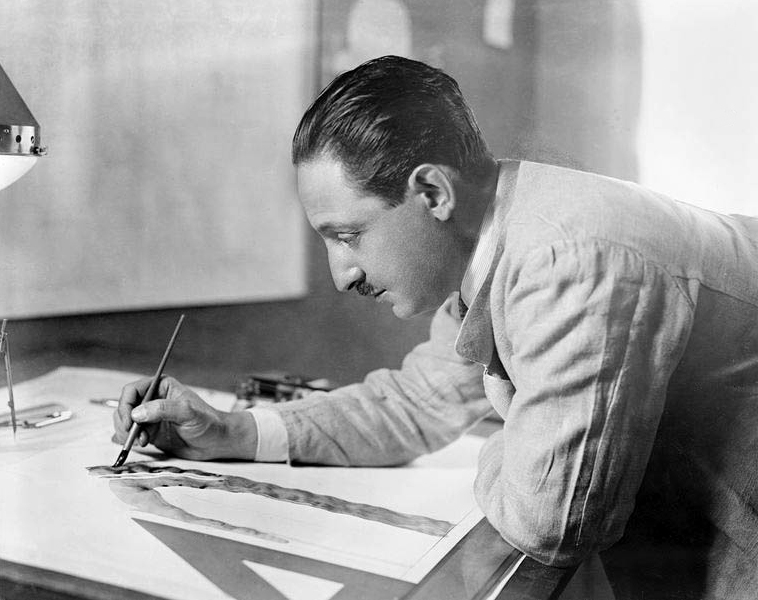|
American Union Of Decorative Artists And Craftsmen
The American Union of Decorative Artists and Craftsmen (AUDAC) was an American society of designers and decorative artists that was active from 1928 until the early 1930s. The group aimed to bring modern principles of design, such as those promoted in Europe by the Wiener Werkstätte and the Bauhaus, to decorative arts in the United States. History The modernist furniture designer Paul T. Frankl immigrated from Vienna to New York in 1914. He worked to establish Europe's flourishing principles of contemporary design in the United States by writing books such as ''New Dimensions: The Decorative Arts of Today'' and by establishing a collective of fellow designers called the American Union of Decorative Artists and Craftsmen (AUDAC) in 1928. Early members included designers who exhibited at the American Designers' Gallery, which showed interiors and furnishings designed by contemporary New York designers, such as Donald Deskey and Ilonka Karasz. AUDAC was modeled on European decora ... [...More Info...] [...Related Items...] OR: [Wikipedia] [Google] [Baidu] |
Paul T
Paul may refer to: *Paul (given name), a given name (includes a list of people with that name) *Paul (surname), a list of people People Christianity *Paul the Apostle (AD c.5–c.64/65), also known as Saul of Tarsus or Saint Paul, early Christian missionary and writer *Pope Paul (other), multiple Popes of the Roman Catholic Church *Saint Paul (other), multiple other people and locations named "Saint Paul" Roman and Byzantine empire *Lucius Aemilius Paullus Macedonicus (c. 229 BC – 160 BC), Roman general *Julius Paulus Prudentissimus (), Roman jurist *Paulus Catena (died 362), Roman notary *Paulus Alexandrinus (4th century), Hellenistic astrologer *Paul of Aegina or Paulus Aegineta (625–690), Greek surgeon Royals *Paul I of Russia (1754–1801), Tsar of Russia *Paul of Greece (1901–1964), King of Greece Other people *Paul the Deacon or Paulus Diaconus (c. 720 – c. 799), Italian Benedictine monk *Paul (father of Maurice), the father of Maurice, Byzan ... [...More Info...] [...Related Items...] OR: [Wikipedia] [Google] [Baidu] |
Pola Stout
Josefine Pola Stout (née Weinbach, January 8, 1902 – October 12, 1984) was an American designer best known for creating fine woolen fabrics. Born in Stryj, she studied with Josef Hoffmann at the Kunstgewerbe Schule in Vienna, and designed for the Wiener Werkstätte before she immigrated to the United States in 1925 with her first husband, architect and designer Wolfgang Hoffmann. Wolfgang and Pola Hoffmann became a prominent interior design team that contributed to the development of American modernism in the early 20th century. They dissolved their successful partnership in 1932, when she married popular mystery author Rex Stout. Pola Stout was an influential textile designer after her second marriage. She was executor of Rex Stout's literary estate after her husband's death in 1975. Biography Pola Stout was born Josefine Pola Weinbach,"Josefine Hoffmann". Ancestry.com. ''New York, Passenger Lists, 1820–1957'' atabase online Provo, Utah: Ancestry.com Operations Inc., 20 ... [...More Info...] [...Related Items...] OR: [Wikipedia] [Google] [Baidu] |
Industrial Design
Industrial design is a process of design applied to physical Product (business), products that are to be manufactured by mass production. It is the creative act of determining and defining a product's form and features, which takes place in advance of the manufacture or production of the product. It consists purely of repeated, often automated, replication, while craft-based design is a process or approach in which the form of the product is determined by the product's creator largely concurrent with the act of its production. All manufactured products are the result of a design process, but the nature of this process can vary. It can be conducted by an individual or a team, and such a team could include people with varied expertise (e.g. designers, engineers, business experts, etc.). It can emphasize intuitive creativity or calculated Evidence-based design, scientific decision-making, and often emphasizes a mix of both. It can be influenced by factors as varied as Raw material, ... [...More Info...] [...Related Items...] OR: [Wikipedia] [Google] [Baidu] |
Graphic Design
Graphic design is a profession, academic discipline and applied art whose activity consists in projecting visual communications intended to transmit specific messages to social groups, with specific objectives. Graphic design is an interdisciplinary branch of design and of the fine arts. Its practice involves creativity, innovation and lateral thinking using manual or digital tools, where it is usual to use text and graphics to communicate visually. The role of the graphic designer in the communication process is that of encoder or interpreter of the message. They work on the interpretation, ordering, and presentation of visual messages. Usually, graphic design uses the aesthetics of typography and the compositional arrangement of the text, ornamentation, and imagery to convey ideas, feelings, and attitudes beyond what language alone expresses. The design work can be based on a customer's demand, a demand that ends up being established linguistically, either orally or in writin ... [...More Info...] [...Related Items...] OR: [Wikipedia] [Google] [Baidu] |
Decorative Arts
] The decorative arts are arts or crafts whose object is the design and manufacture of objects that are both beautiful and functional. It includes most of the arts making objects for the interiors of buildings, and interior design, but not usually architecture. Ceramic art, metalwork, furniture, jewellery, fashion, various forms of the textile arts and glassware are major groupings. Applied arts largely overlaps with decorative arts, and the modern making of applied art is usually called design. The decorative arts are often categorized in distinction to the " fine arts", namely painting, drawing, photography, and large-scale sculpture, which generally produce objects solely for their aesthetic quality and capacity to stimulate the intellect. Distinction from the fine arts The distinction between the decorative and fine arts essentially arose from the post-Renaissance art of the West, where the distinction is for the most part meaningful. This distinction is much less meani ... [...More Info...] [...Related Items...] OR: [Wikipedia] [Google] [Baidu] |
Frank Lloyd Wright
Frank Lloyd Wright (June 8, 1867 – April 9, 1959) was an American architect, designer, writer, and educator. He designed more than 1,000 structures over a creative period of 70 years. Wright played a key role in the architectural movements of the twentieth century, influencing architects worldwide through his works and hundreds of apprentices in his Taliesin Fellowship. Wright believed in designing in harmony with humanity and the environment, a philosophy he called organic architecture. This philosophy was exemplified in Fallingwater (1935), which has been called "the best all-time work of American architecture". Wright was the pioneer of what came to be called the Prairie School movement of architecture and also developed the concept of the Usonian home in Broadacre City, his vision for urban planning in the United States. He also designed original and innovative offices, churches, schools, skyscrapers, hotels, museums, and other commercial projects. Wright-designed inter ... [...More Info...] [...Related Items...] OR: [Wikipedia] [Google] [Baidu] |
Kem Weber
Karl Emanuel Martin "Kem" Weber (1889–1963) was an American furniture and industrial designer, architect, art director, and teacher who created several iconic designs of the 'Streamline' style. Early career Born in Berlin, Germany, Weber initially trained under the royal cabinet maker Eduard Schultz in Potsdam, before enrolling at the Kunstgewerbeschule (School of applied arts) in Berlin in 1908 where he studied under Bruno Paul. Graduating in 1912, Weber went on to work in Paul's office, having previously assisted his tutor in the design of the German pavilion at the 1910 'Exposition Universelle (1910), Exposition Universalle' in Brussels. It was the design of a second pavilion that proved to be the turning point in Weber's career. Paul sent his assistant to San Francisco, California, to supervise work on the German pavilion being built for the Panama-Pacific International Exposition of 1915. However, Weber was soon overtaken by other international events. The onset of Wo ... [...More Info...] [...Related Items...] OR: [Wikipedia] [Google] [Baidu] |
Edward Buk Ulreich
Edward Buk Ulreich (February 12, 1884 – July 17, 1966) was an American artist. Born in Hungary, his work includes murals at the United States Courthouse (Tallahassee, Florida, 1936) completed in 1939. His work is also at the National Museum of American Illustration. The U.S. Courthouse in Tallahassee's main lobby is decorated with eight murals by Ulreich illustrating scenes from Florida's history. The murals were funded by the Treasury Department's Section of Painting and Sculpture, a New Deal program that commissioned artists. Ulreich won a competition to paint the murals, which he completed in 1939. He also painted Southwestern motifs and worked as an illustrator. History Born in Kőszeg in Austria-Hungary in 1889 Ulreich came to Kansas City, Missouri with his family as a baby. He studied under Mlle F. Blumberg and at the Kansas City Art Institute and worked as a cowboy on the Apache Indian reservation in Arizona. He sent a painting to the Pennsylvania Academy of the ... [...More Info...] [...Related Items...] OR: [Wikipedia] [Google] [Baidu] |
Edward Steichen
Edward Jean Steichen (March 27, 1879 – March 25, 1973) was a Luxembourgish American photographer, painter, and curator, renowned as one of the most prolific and influential figures in the history of photography. Steichen was credited with transforming photography into an art form. His photographs appeared in Alfred Stieglitz's groundbreaking magazine ''Camera Work'' more often than anyone else during its publication run from 1903 to 1917. Stieglitz hailed him as "the greatest photographer that ever lived". As a pioneer of fashion photography, Steichen's gown images for the magazine ''Art et Décoration'' in 1911 were the first modern fashion photographs to be published. From 1923 to 1938, Steichen served as chief photographer for the Condé Nast magazines ''Vogue'' and '' Vanity Fair'', while also working for many advertising agencies, including J. Walter Thompson. During these years, Steichen was regarded as the most popular and highest-paid photographer in the world. After ... [...More Info...] [...Related Items...] OR: [Wikipedia] [Google] [Baidu] |
Lee Simonson
Lee Simonson (June 26, 1888, New York City – January 23, 1967, Yonkers) was an American architect painter, stage setting designer. He acted as a stage set designer for the Washington Square Players (1915–1917). When it became the Theatre Guild in 1919, he became a stage setting staff of the theater. Literary works *“Skyscrapers for Art Museums” ''The American Mercury'', August 1927, pages 399-404 *"Minor Prophecies" New York, Harcourt and Brace, 1927 *"The Stage Is Set", New York, Dover Publications, 1932 *(with Theodore Komisarjevsky): "Settings and Costumes of the Modern Stage" New York Studio Productions, 1933 *Isaacs, Edith J.R., editor: "Architecture for the New Theater" Lee Simonson: "Theater Planning" New York Theater Arts, 1935 * ''Part of a lifetime: Drawings and Designs 1919-1940'', Duell, Sloan and Pearce, New York 1943 * ''The Art of Scenic Design; A Pictorial Analysis of Stage Setting and its relation to Theatrical Production'', 1950 Exhibitions *"Mod ... [...More Info...] [...Related Items...] OR: [Wikipedia] [Google] [Baidu] |
Winold Reiss
F. Winold Reiss (September 16, 1886 – August 23, 1953) was a German-born American artist and graphic designer. He was born in Karlsruhe, Germany, the second son of Fritz Reiss (1857–1914) and his wife. He grew up surrounded by art, as his father was a well-known landscape artist and his brother became a sculptor. Reiss became a portraitist. His philosophy was that an artist must travel to find the most interesting subjects; influenced by his father and his own curiosity, he drew subjects from many peoples and walks of life. In 1913 he immigrated to the United States, where he was able to follow his interest in Native Americans. In 1920 he went West for the first time, working for a lengthy period on the Blackfeet Reservation. Over the years Reiss painted more than 250 works depicting Native Americans. These paintings by Reiss became known more widely beginning in the 1920 and to the 1950s, when the Great Northern Railway commissioned Reiss to do paintings of the Blackfeet wh ... [...More Info...] [...Related Items...] OR: [Wikipedia] [Google] [Baidu] |



.jpg)



